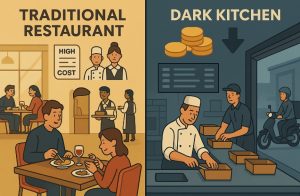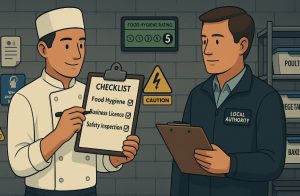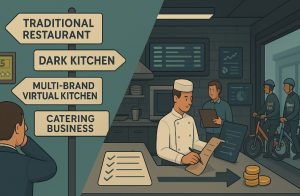In recent years, the UK’s food industry has undergone a significant transformation. One of the most innovative and disruptive developments is the emergence of the dark kitchen business model.
Also known as ghost kitchens, cloud kitchens, or virtual kitchens, these are delivery-only food production facilities that operate without a traditional dine-in area or customer-facing presence.
The COVID-19 pandemic accelerated this trend, as restrictions on in-person dining led many restaurants to explore alternatives to stay afloat. However, dark kitchens are not merely a temporary response to a crisis; they are part of a larger shift towards digitisation, convenience, and cost-effective business models within the hospitality sector.
This blog delves into what is a dark kitchen business, how it operates, the different models available, and the key benefits and challenges that come with it. Whether you’re a budding food entrepreneur or an established brand exploring new revenue streams, understanding this model is essential for navigating the future of food service.
What is a Dark Kitchen Business?
A dark kitchen refers to a commercial food production space designed solely for delivery services. These facilities do not offer a dining area or takeaway counter and instead fulfil orders placed online via delivery platforms such as Deliveroo, Just Eat, and Uber Eats.
Customers place an order through an app, the kitchen prepares the meal, and a delivery rider collects and delivers it to the customer’s location.
This streamlined process cuts out the need for customer-facing staff, furniture, interior décor, and high-street rental costs, making it an attractive business model for those looking to enter the food industry at a lower cost.
The concept has allowed restaurants to reach customers in areas with high demand but limited supply, without the need to invest in full-scale establishments. It has also provided an opportunity for virtual brands to emerge as brands that exist exclusively on delivery apps with no physical storefront.
How Does a Dark Kitchen Business Operate in the UK?
Dark kitchens in the UK operate in several forms, depending on who owns and manages the kitchen space and how services are delivered. Operations typically involve preparing food in a commercial-grade kitchen, managing online orders, and coordinating with third-party delivery drivers.
Many of these kitchens are located in industrial estates or less visible parts of towns and cities. Their back-end setup focuses purely on efficiency, cleanliness, and output capacity. The goal is to prepare and dispatch meals as quickly and cost-effectively as possible.
A typical process looks like this:
| Step | Description |
| 1 | A customer places an order via a food delivery app. |
| 2 | The order is received by the dark kitchen through an integrated POS or dashboard. |
| 3 | Staff prepare and package the order. |
| 4 | A delivery rider is notified when the order is ready. |
| 5 | The food is collected and delivered to the customer. |
This model eliminates overheads related to customer service and high-street branding while prioritising operational efficiency and profitability.
What Are the Benefits of Starting a Dark Kitchen in the UK?

Dark kitchens offer substantial advantages for both new and existing food businesses. Perhaps the most attractive benefit is the reduced cost of entry into the market. Operators can start a delivery-only food business for a fraction of the cost of a traditional restaurant.
Key benefits include:
- Lower operational costs: No need for waitstaff, dining space, or expensive city-centre rentals.
- Faster scalability: Brands can launch multiple locations quickly based on delivery data and demand.
- Testing new concepts: Businesses can experiment with menus or create entirely new brands without committing to a full storefront.
- Higher efficiency: The kitchens are purpose-built for delivery, reducing wastage and improving turnaround times.
Established brands also use dark kitchens to extend their delivery reach. For example, a successful central London restaurant may use a dark kitchen in outer zones to serve suburbs and surrounding towns, without opening additional physical locations.
What Challenges Do Dark Kitchen Operators Face?
While dark kitchens offer many benefits, they are not without their challenges. Operators must be aware of logistical, financial, and branding obstacles that could impact long-term viability.
One of the main challenges is the high commission charged by delivery platforms, which can significantly affect margins. Additionally, without a physical store, it can be harder to build customer loyalty or provide memorable brand experiences.
Common challenges include:
- Heavy reliance on delivery apps: Platforms may charge 25–35% in fees.
- Brand visibility and trust: Without a physical location, building customer trust can be difficult.
- Operational complexity: Managing multiple brands and platforms requires strong logistics.
- Staff welfare concerns: There have been criticisms about workers operating in confined, high-pressure environments.
There is also the risk of market saturation, especially in densely populated urban areas where multiple dark kitchens may compete for the same customer base.
What Are the Legal and Regulatory Considerations?

Operating a dark kitchen in the UK comes with its share of regulatory responsibilities. Even though these kitchens do not serve customers on-site, they must comply with all food hygiene and business operation laws.
| Requirement | Details |
| Business Registration | Must register with the local authority at least 28 days before trading. |
| Food Hygiene Rating | Subject to inspection by the Food Standards Agency (FSA). |
| Health & Safety Compliance | Must adhere to fire safety, pest control, and sanitation regulations. |
| Insurance | Includes public liability, employer’s liability, and commercial property insurance. |
| Licensing | Depending on operation hours, a late-night refreshment licence may be needed. |
Even if the kitchen is leased from a third party, the food business operator is responsible for maintaining standards.
How is Technology Driving the Dark Kitchen Trend?
Technology is at the core of the dark kitchen model. These kitchens rely on a suite of tools to manage orders, streamline workflows, analyse customer behaviour, and deliver consistently high-quality food.
Software integrations allow orders from multiple platforms to flow into a single dashboard, enabling real-time tracking and analytics. These insights help operators determine popular dishes, customer preferences, and delivery efficiency.
Technology also enables the development of virtual brands, allowing kitchens to experiment with niche offerings without incurring additional overheads.
Common tech tools used:
| Technology | Function |
| POS Systems | Manage multiple delivery platforms from one dashboard. |
| Smart Kitchen Appliances | Improve the speed and consistency of cooking. |
| Analytics Software | Track performance, popular menu items, and customer feedback. |
| Delivery Integration | Coordinate with delivery drivers for smooth handovers. |
Companies like Flavour Factory help food entrepreneurs launch and refine virtual brands by providing end-to-end support, from menu design to platform listings.
What Are Some Successful Dark Kitchen Models in the UK?
There are multiple operating models for dark kitchens, each with different advantages:
| Model Type | Description | Example |
| Single Brand Kitchen | One restaurant brand runs its own kitchen purely for delivery. | McDonald’s Hanworth dark kitchen |
| Multi-Brand Kitchen | One kitchen serves several virtual or real brands. | Tiny Cloud Kitchen |
| Delivery Platform Kitchen | A delivery app provides space and support to food businesses. | Deliveroo Editions |
| Commercial Kitchen Rental | Third parties lease kitchen spaces to various operators. | FoodStars, Karma Kitchen |
| Dark Kitchen Marketplace | Connects landlords with underused kitchen space to food brands. | Oya Kitchens |
Some successful operators include:
- Deliveroo Editions, which supports brands like Dishoom, Five Guys, and Rosa’s Thai.
- FoodStars, with over 100 kitchen spaces across 17 locations.
- Taster, operating a collection of virtual brands across the UK.
- Atcha Cloudtown Kitchen, specialising in Malaysian cuisine from London-based delivery kitchens.
Is a Dark Kitchen the Right Choice for Your Food Business?

Choosing the right dark kitchen model requires careful planning and self-assessment. Factors such as budget, target location, branding goals, and operational capacity should all be considered.
Here’s a breakdown of considerations:
| Criteria | Questions to Consider |
| Resources | Can you manage all operations or would you prefer to outsource? |
| Market Demand | Is there unmet demand for certain cuisines in the target area? |
| Location | Can you save on rent by choosing an industrial site? |
| Scalability | Is the model easily replicable in new areas? |
| Compliance | Can you meet food safety and licensing requirements? |
| Marketing | Do you have a strategy for building your brand online? |
Understanding these variables will help you choose between different models and ensure your dark kitchen is built for success.
What Does the Future Hold for Dark Kitchen Businesses?
The dark kitchen industry is positioned for growth, driven by consumer preferences for convenience, affordability, and speed. Research by Euromonitor International predicts that food delivery could become a $1 trillion industry by 2030.
While the dark kitchen model isn’t suited for every brand, it offers a flexible and scalable alternative to traditional restaurants. For many, it represents a future in which food brands are not confined by physical walls, but shaped by data, demand, and delivery potential.
FAQs About Dark Kitchens
Are dark kitchens profitable in the UK?
Yes, especially when optimised for operational efficiency and partnered with major delivery platforms. However, profitability depends heavily on managing overheads and commission fees.
What’s the difference between a ghost kitchen and a dark kitchen?
While often used interchangeably, ghost kitchens usually refer to facilities tied to existing restaurants, whereas dark kitchens are often independent, delivery-only operations.
Do I need a restaurant licence to run a dark kitchen?
Not necessarily, but you must register with your local authority and comply with all food hygiene and health and safety regulations.
How do I start a dark kitchen in the UK?
Create a business plan, secure a kitchen space, obtain necessary licences, and partner with delivery platforms. Choose a model that fits your resources and goals.
Can I operate multiple brands from one dark kitchen?
Yes. Multi-brand dark kitchens are common and allow operators to target various customer segments efficiently.
What are the typical costs involved in running a dark kitchen?
Costs include kitchen rental, staff wages, equipment, utilities, ingredients, packaging, and delivery commissions.
Are dark kitchens sustainable as a long-term model?
Yes, especially as food delivery demand continues to grow. They offer a flexible, tech-powered approach to modern food service.




